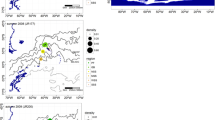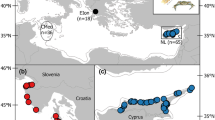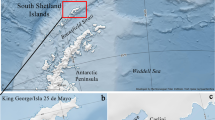Abstract
To clarify the factors that affect spatiotemporal isotopic variations in fishes, we examined stable carbon and nitrogen isotope ratios (δ13C and δ15N) of Japanese jack mackerel Trachurus japonicus larvae and juveniles sampled in the shelf break region of the East China Sea (ECS) in April during six consecutive surveys (2005–2010). The δ13C values in fish tissues were similar between northern and southern ECS, while δ15N values were higher in the southern ECS, probably because of lower nitrogen fixation and the presence of fish with larger body size occupying a higher trophic level. Interannual variations in δ15N of T. japonicus juveniles might be mainly contributed by the variation in the abundance of the main diet such as Oncaeidae copepodites and Corycaeus. The isotopic overlaps between epipelagic T. japonicus larvae and other dominant mesopelagic fish larvae were negligible, suggesting lesser competition for food resources. Knowledge regarding spatiotemporal variation in stable isotope ratios of T. japonicus can be applied to understand the feeding habits and migrations of fishes in the ECS.





Similar content being viewed by others
References
Chen CA (2008) Distributions of nutrients in the East China Sea and the South China Sea connection. J Oceanogr 64:737–751
Chen M, Kim D, Liu H, Kang C-K (2018) Variability in copepod trophic levels and feeding selectivity based on stable isotope analysis in Gwangyang Bay of the southern coast of the Korean Peninsula. Biogeosciences 15:2055–2073
Chihara M, Murano M (1997) An illustrated guide to marine plankton in Japan. Tokai University Press, Tokyo (in Japanese)
Dupuy C, Pagano M, Got P, Domaizon I, Chappuis A, Marchessaux G, Bouvy M (2016) Trophic relationships between metazooplankton communities and their plankton food sources in the Iles Eparses (Western Indian Ocean). Mar Environ Res 116:18–31
Flynn AJ, Kloser RJ (2012) Cross-basin heterogeneity in lanternfish (family Myctophidae) assemblages and isotopic niches (δ 13C and δ 15N) in the southern Tasman Sea abyssal basin. Deep Sea Res Part I 69:113–127
Gao L, Li D, Ishizaka J (2014) Stable isotope ratios of carbon and nitrogen in suspended organic matter: seasonal and spatial dynamics along the Changjiang (Yangtze River) transport pathway. J Geophys Res Biogeosci 119:1717–1737
García A, Laiz-Carrión R, Uriarte A, Quintanilla JM, Morote E, Rodríguez JM, Alemany F (2017) Differentiated stable isotopes signatures between pre- and post-flexion larvae of Atlantic bluefin tuna (Thunnus thynnus) and of its associated tuna species of the Balearic Sea (NW Mediterranean). Deep Sea Res Part II 140:18–24
Giraldo C, Cherel Y, Vallet C, Mayzaud P, Tavernier E (2011) Ontogenic changes in the feeding ecology of the early life stages of the Antarctic silverfish (Pleuragramma antarcticum) documented by stable isotopes and diet analysis in the Dumont d’Urville Sea (East Antarctica). Polar Sci 5:252–263
Goering J, Alexander V, Haubenstock N (1990) Seasonal variability of stable carbon and nitrogen isotope ratios of organisms in a North Pacific Bay. Estuar Coast Shelf Sci 30:239–260
Guelinckx J, Maes J, Van Den Driessche P, Geysen B, Dehairs F, Ollevier F (2007) Changes in δ 13C and δ 15N in different tissues of juvenile sand goby Pomatoschistus minutus: a laboratory diet-switch experiment. Mar Ecol Prog Ser 341:205–215
Hirota Y, Honda H, Sakaji H, Uehara S, Ichikawa T (2016) Ontogenetic changes of feeding habits of larval jack mackerel Trachurus japonicus in the Kuroshio frontal area of the southern East China Sea. Fish Sci 82:573–583
Kiernan JA (2000) Formaldehyde, formalin, paraformaldehyde and glutaraldehyde: what they are and what they do. Micros Today 00–1:8–12
Kuwahara A, Suzuki S (1982) Vertical distribution and feeding habits of a horse mackerel Trachurus japonicus and a barracuda Sphyraena pinguis larvae in the western Wakasa Bay. Bull Kyoto Inst Ocean Fish Sci 6:13–17
Liénart C, Feunteun E, Miller MJ, Aoyama J, Mortillaro J-M, Hubas C, Kuroki M, Watanabe S, Dupuy C, Otake T, Tsukamoto K, Meziane T (2015) Geographic variation in stable isotopic and fatty acid composition of three families of anguilliform leptocephali and particulate organic matter (POM) in the western South Pacific. Mar Ecol Prog Ser 544:225–241
Liu Q, Kandasamy S, Lin B, Wang H, Chen CA (2018) Biogeochemical characteristics of suspended particulate matter in deep chlorophyll maximum layers in the southern East China Sea. Biogeosciences 15:2091–2109
Lorrain A, Graham BS, Popp BN, Allain V, Olson RJ, Hunt BPV, Potier M, Fry B, Galván-Magaña F, Menkes CER, Kaehler S, Ménard F (2015) Nitrogen isotopic baselines and implications for estimating foraging habitat and trophic position of yellowfin tuna in the Indian and Pacific Oceans. Deep Sea Res Part II 113:188–198
MacKenzie KM, Palmer MR, Moore A, Ibbotson AT, Beaumont WRC, Poulter DJS, Trueman CN (2011) Locations of marine animals revealed by carbon isotopes. Sci Rep 1:21
McCutchan JH, Lewis WM, Kendall C, McGrath CC (2003) Variation in trophic shift for stable isotope ratios of carbon, nitrogen, and sulfur. Oikos 102:378–390
Mei W, Umezawa Y, Wan X, Yuan J, Sassa C (2018) Feeding habits estimated from weight-related isotope variations of mesopelagic fish larvae in the Kuroshio waters of the northeastern East China Sea. ICES J Mar Sci. https://doi.org/10.1093/icesjms/fsy016
Minagawa M, Wada E (1984) Stepwise enrichment of 15N along food chains: further evidence and the relation between δ 15N and animal age. Geochim Cosmochim Acta 48:1135–1140
Miyachi S, Mayahara T, Tsushima K, Sasada K, Kohno E, Ogawa NO, Chikaraishi Y, Ohkouchi N (2015) Approach to determine individual trophic level and the difference in food sources of Japanese anchovy Engraulis japonicus in Sagami Bay, based on compound-specific nitrogen stable isotope analysis of amino acids. Fish Sci 81:1053–1062
Montoya JP (2007) Natural abundance of 15N in marine planktonic ecosystems. In: Michener RH, Lajtha K (eds) Stable isotopes in ecology and environmental science, 2nd edn. Blackwell Publication, Malden, MA, pp 176–201
Ogawa NO, Nagata T, Kitazato H, Ohkouchi N (2010) Ultra-sensitive elemental analyzer/isotope ratio mass spectrometer for stable nitrogen and carbon isotope analyses. In: Ohkouchi N, Tayasu I, Koba K (eds) Earth, life, and isotopes. Kyoto University Press, Kyoto, pp 339–353
Ogawa NO, Chikaraishi Y, Ohkouchi N (2013) Trophic position estimates of formalin-fixed samples with nitrogen isotopic compositions of amino acids: an application to gobiid fish (Isaza) in Lake Biwa, Japan. Ecol Res 28:697–702
Ohkouchi N, Ogawa NO, Chikaraishi Y, Tanaka H, Wada E (2015) Biochemical and physiological bases for the use of carbon and nitrogen isotopes in environmental and ecological studies. Prog Earth Planet Sci. https://doi.org/10.1186/s40645-015-0032-y
Okiyama M (2014) An atlas of the early stage fishes in Japan, 2nd edn. Tokai University Press, Tokyo (in Japanese)
Oozeki Y, Watanabe Y, Kitagawa D (2004) Environmental factors affecting larval growth of Pacific saury, Cololabis saira, in the northwestern Pacific Ocean. Fish Oceanogr 13:44–53
Post DM (2002) Using stable isotopes to estimate trophic position: models, methods, and assumptions. Ecology 83:703–718
Rau GH, Ainley DG, Bengtson JL, Torres JJ, Hopkins TL (1992) 15N/14N and 13C/12C in Weddell Sea birds, seals, and fish: implications for diet and trophic structure. Mar Ecol Prog Ser 84:1–8
Sano M, Maki K, Nishibe Y, Nagata T, Nishida S (2013) Feeding habits of mesopelagic copepods in Sagami Bay: insights from integrative analysis. Prog Oceanogr 110:11–26
Sarakinos HC, Johnson ML, Vander Zanden MJ (2002) A synthesis of tissue-preservation effects on carbon and nitrogen stable isotope signatures. Can J Zool 80:381–387
Sassa C, Konishi Y (2015) Late winter larval fish assemblage in the southern East China Sea, with emphasis on spatial relations between mesopelagic and commercial pelagic fish larvae. Cont Shelf Res 108:97–111
Sassa C, Tsukamoto Y (2012) Inter-annual comparison of diet and daily ration of larval jack mackerel Trachurus japonicus in the southern East China Sea. J Plankton Res 34:173–187
Sassa C, Konishi Y, Mori K (2006) Distribution of jack mackerel (Trachurus japonicus) larvae and juveniles in the East China Sea, with special reference to the larval transport by the Kuroshio current. Fish Oceanogr 15:508–518
Sassa C, Takahashi M, Nishiuchi K, Tsukamoto Y (2014) Distribution, growth and mortality of larval jack mackerel Trachurus japonicus in the southern East China Sea in relation to oceanographic conditions. J Plankton Res 36:542–556
Sassa C, Takahashi M, Konishi Y, Tsukamoto Y (2016) Interannual variations in distribution and abundance of Japanese jack mackerel Trachurus japonicus larvae in the East China Sea. ICES J Mar Sci 73:1170–1185
Sassa C, Kitajima S, Nishiuchi K, Takahashi M (2018) Ontogenetic and inter-annual variation in the diet of Japanese jack mackerel (Trachurus japonicus) juveniles in the East China Sea. J Mar Biol Assoc UK. https://doi.org/10.1017/s0025315418000206
Shiozaki T, Furuya K, Kodama T, Kitajima S, Takeda S, Takemura T, Kanda J (2010) New estimation of N2 fixation in the western and central Pacific Ocean and its marginal seas. Global Biogeochem Cycles. https://doi.org/10.1029/2009gb003620
Shiozaki T, Takeda S, Itoh S, Kodama T, Liu X, Hashihama F, Furuya K (2015) Why is Trichodesmium abundant in the Kuroshio? Biogeosciences 12:6931–6943
Sigman DM, Karsh KL, Casciotti KL (2009) Nitrogen isotopes in the ocean. Encyclopedia of ocean sciences. Elsevier, Amsterdam, pp 40–54
Syväranta J, Martino A, Kopp D, Céréghino R, Santoul F (2011) Freezing and chemical preservatives alter the stable isotope values of carbon and nitrogen of the Asiatic clam (Corbicula fluminea). Hydrobiologia 658:383–388
Takahashi M, Sassa C, Nishiuchi K, Tsukamoto Y (2016) Interannual variations in rates of larval growth and development of jack mackerel (Trachurus japonicus) in the East China Sea: implications for juvenile survival. Can J Fish Aquat Sci 73:155–162
Takahashi M, Sassa C, Nishiuchi K, Tsukamoto Y (2018) Variability in growth rates of Japanese jack mackerel Trachurus japonicus in the East China Sea—effects of temperature and prey abundance. In: Nagai T, Saito H, Suzuki K, Takahashi M (eds) Kuroshio Current. Physical, biogeochemical and ecosystem dynamics. American Geophysical Union, Washington (in press)
Tanaka H, Yoneda M, Kitano H, Kawamura K, Imanaga Y, Matsuyama M, Okamura K, Ohshimo S (2016) Stable isotope evidence for income resource allocation to egg production in the Japanese anchovy Engraulis japonicus. Mar Biol 163:28–33
Thavarajah R, Mudimbaimannar VK, Elizabeth J, Rao UK, Ranganathan K (2012) Chemical and physical basics of routine formaldehyde fixation. J Oral Maxillofac Pathol 16:400–405
Uriarte A, García A, Ortega A, de la Gándara F, Quintanilla J, Laiz-Carrión R, Laiz-Carrión R (2016) Isotopic discrimination factors and nitrogen turnover rates in reared Atlantic bluefin tuna larvae (Thunnus thynnus): effects of maternal transmission. Sci Mar 80:447–456
Vanderklift MA, Ponsard S (2003) Sources of variation in consumer-diet δ 15N enrichment: a meta-analysis. Oecologia 136:169–182
Viola MNP, Riccialdelli L, Jaureguizar A, Panarello HO, Cappozzo HL (2018) Variation in the isotopic composition of striped weakfish Cynoscion guatucupa of the Southwest Atlantic Ocean in response to dietary shifts. Braz J Biol 78:202–210
Wells RJD, Rooker JR (2009) Feeding ecology of pelagic fish larvae and juveniles in slope waters of the Gulf of Mexico. J Fish Biol 75:1719–1732
Woodcock P, Edwards DP, Newton RJ, Edwards FA, Khen CV, Bottrell SH, Hamer KC (2012) Assessing trophic position from nitrogen isotope ratios: effective calibration against spatially varying baselines. Naturwissenschaften 99:275–283
Wu Y, Zhang J, Li DJ, Wei H, Lu RX (2003) Isotope variability of particulate organic matter at the PN section in the East China Sea. Biogeochemistry 65:31–49
Wu C-R, Lu H-F, Chao S-Y (2008) A numerical study on the formation of upwelling off northeast Taiwan. J Geophys Res 113:C08025. https://doi.org/10.1029/2007JC004697
Zhang R, Chen M, Cao J, Ma Q, Yang J, Qiu Y (2012) Nitrogen fixation in the East China Sea and southern Yellow Sea during summer 2006. Mar Ecol Prog Ser 447:77–86
Acknowledgements
We are grateful to the captains, officers and crews of RV Yoko-Maru for their assistances in the field sampling. We also thank the Fisheries Agency of Japan for sharing the fish samples for SI ratios analyses. This study was financially supported by the Study of Kuroshio Ecosystem Dynamics for Sustainable Fisheries (SKED), funded by the MEXT (Ministry of Education, Culture, Sports, Science and Technology), Japan.
Author information
Authors and Affiliations
Corresponding author
Electronic supplementary material
Below is the link to the electronic supplementary material.
Rights and permissions
About this article
Cite this article
Mei, W., Umezawa, Y., Wan, X. et al. Factors controlling spatiotemporal variations in stable nitrogen isotopes of Trachurus japonicus larvae and juveniles in the East China Sea. Fish Sci 85, 71–80 (2019). https://doi.org/10.1007/s12562-018-1267-5
Received:
Accepted:
Published:
Issue Date:
DOI: https://doi.org/10.1007/s12562-018-1267-5




